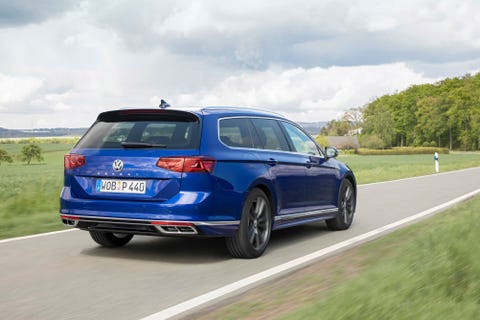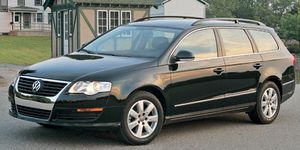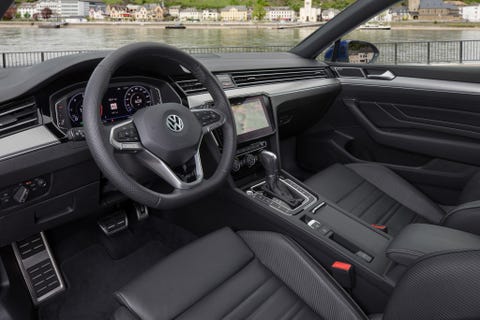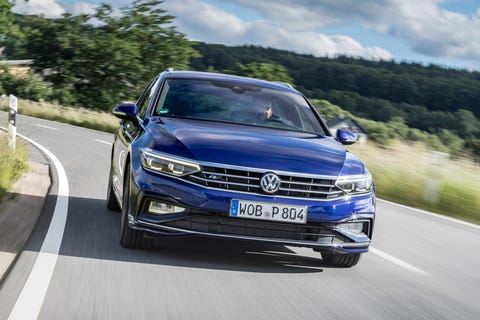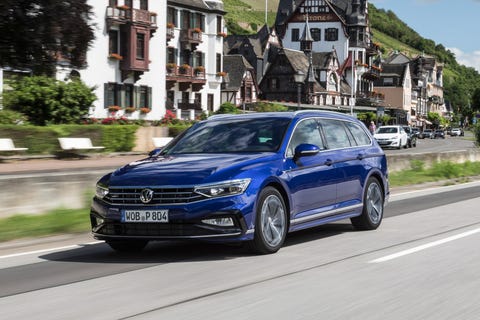Back in 2011, Volkswagen announced that it would call its new big sedan for the United States market the Passat. VW’s new Tennessee-build sedan might have had the same name as the Passat in Europe, but the two cars were different. America’s Passat would be a spacious and affordable four-door. Europe’s Passat would be a different car on a different platform.
That evolutionary divergence remains today. The 2020 Passat that Americans can buy starts at $22,995, and the only engine offered is a 174-hp turbocharged 2.0-liter four-cylinder mated to a six-speed automatic. A comprehensive redesign means it’s a credible choice in a competitive segment that includes the Toyota Camry and Honda Accord.
VW showrooms in Europe have a Passat that’s built atop the latest MQB architecture and is closely related to the Arteon. The Euro Passat is available with turbocharged 1.5- and 2.0-liter gasoline engines that start at 148 horsepower and top off at 268 horsepower. Two optional turbo-diesel engines sized 1.6 and 2.0 liters range from 148 to 236 horsepower, and the lineup includes both a plug-in hybrid and a crossover model dubbed the Alltrack. We ordered up a European Passat Variant wagon to see if we’re missing out.
With so many choices, it’s difficult to settle on one vehicle to represent the European Passat Variant, but we opted for a top-of-the-line gasoline model over the torque-rich diesel. The 268-hp 2.0-liter turbo four is related to the U.S. Passat’s engine, but it’s actually what you’d find under the hood of the Arteon. Unlike the Arteon, which has a conventional eight-speed automatic transmission, the European Passat gets a seven-speed dual-clutch automatic, and the power flows to all four wheels. Europe, of course, gets manuals as well, although only on low-powered models.
While we lament the demise of the 3.6-liter VR6 engine for mostly nostalgic reasons, the 2.0-liter is as smooth and unobtrusive as fours get, and it builds speed with effortless grace well into the triple digits. According to VW’s numbers, the sprint from zero to 62 mph takes 5.8 seconds in the station wagon version, and sedans are 0.2 second quicker. On an empty stretch of autobahn, we were able to reach the Passat’s 155-mph top speed with ease. Fuel economy goes out of the window if you push a Passat that hard, but if you keep a disciplined right foot, we expect highway fuel economy in the high 20s.
The Passat’s structure and chassis is infused with nicely weighted and precise steering. Our test car was fitted with the adaptive suspension, and in the most dynamic setting, its agility makes it act and feel like a slightly bigger GTI. The Arteon has similar dynamics and has the same ability to be fun but also quiet and comfortable enough to serve as an effortless long-distance cruiser.
While the hardware proves that VW still knows its game, we were less impressed by the new infotainment system that the company rolled out with much fanfare. The navigation system is less intuitive than before, and the style of the digital gauges lacks elegance or simplicity. You’re often left wishing for physical buttons. VW, in fact, needs to iron out more than a few wrinkles with this system. On the other hand, the voice recognition system works really well.
Our test car was fitted with a plethora of assistance systems that VW calls Travel Assist. You get partially autonomous driving at cruising speed—up to 130 mph—but it didn’t inspire enough confidence to reduce behind-the-wheel stress. On the other hand, we loved the matrix LED headlights that turn the night into the day with bright, icy light. It actively spares oncoming traffic and cars ahead by moving the illumination around to avoid dazzling other drivers. Sadly, the light-bending headlights are not available in the U.S.
On long drives with many VWs, we came to appreciate the optional Dynaudio sound system, a class-leading 700-watt system that truly turns this car into a concert hall. We hear that VW is about to drop its relationship with Dynaudio in favor of lesser brands, which would be a huge shame.
On a lesser critical note, it is unfortunate that VW killed the analog clock that sat between the central air vents, as it was one of the few elegant elements in an otherwise somewhat stark-looking interior. Instead of the clock, there’s an insert that says Passat just in case you forgot where you are. On our test car, the somewhat restrained exterior of the new Passat benefited from the sportiness of the R-line package.
While the U.S.-market’s Passat attacks the lower end of the sedan market, the European version is set up-market, just like the handsome Arteon. This reach toward the premium brands comes at a price. Our test car came in at more than 50,000 euros, and then there’s the obligatory 19-percent sales tax. That comes to about $55,000. So, you could get two American Passats for the price of one European one and still have money left over, which is a major reason why we don’t get the European Passat but get the stylish Arteon instead.
Source: Reviews - aranddriver.com

